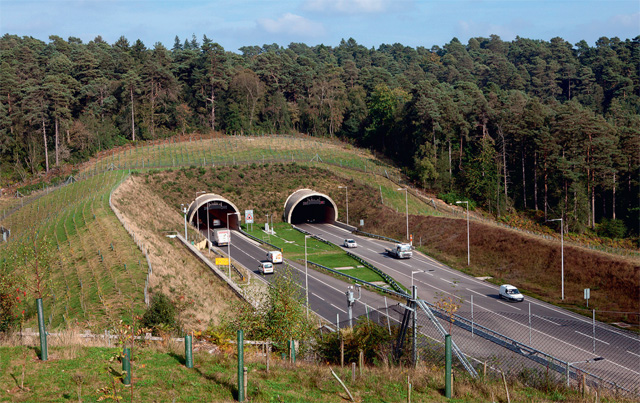New troubles for Hindhead
New housing means further headaches for Surrey's highest village


Three years after the opening of the £370 million Hindhead tunnel, a new ‘blight' is afflicting Surrey's highest village. Two-mile traffic jams at the former crossroads have been replaced by high-density new housing, which is advancing towards the Devils Punchbowl, an AONB and SSSI that is increasingly popular, following the reconnection of the ancient commons previously severed by the A3. Hindhead first developed when the Victorian scientist John Tyndall promoted its clean air and dubbed it ‘Little Switzerland'. Figures such as Sir George Bernard Shaw and Sir Arthur Conan Doyle bought houses, some commissioned from ‘local' architect Sir Edwin Lutyens, and the commons were an early purchase by National Trust co-founder Sir Robert Hunter.
The twin-bore tunnel was expected to bring relief and stakeholders, including the National Trust and Natural England, formulated a ‘concept' to regenerate the redundant stub road. However, it's understood that Waverley Council was told by the Government to ‘at least' double housing targets in its new Local Plan. Thirty-six flats and houses are near completion on the first of six anticipated plots along th ‘stub' road-one apartment block has been described as ‘Dickensian'.
Locals fear further land sales and ‘garden grab' on the Punchbowl boundary. There are also new traffic problems. ‘The idea was to create a village atmosphere, but with the opening of the Punchbowl to wider public use, people park on the stub road-it's a mess,' says residents' association chairman Ian Clifton. Local Sally Catchpole comments: ‘I don't understand how you are allowed to pack houses in so close to an AONB. No thought seems to have been given to where all the families will find work, schools or parking.'
Waverley Council says it never agreed to a cap on housing numbers. A spokes comments: ‘The developments have enhanced and improved the area significantly-we should remind ourselves that three years ago the area was blighted by the A3 traffic. The Council follows policies set out in the Local Plan and national guidance in relation to AONBs and SSSIs.' A National Trust statement says: ‘Whilst the Government is rightly supporting higher housing figures overall, there is a risk that these will end up in the wrong places and that these higher figures are proving difficult for some councils to accommodate. We are asking the Government to keep rigid requirements on local planning authorities to demonstrate a five-year land supply under review.'
* Subscribe to Country Life and save
* Follow Country Life magazine on Twitter
Sign up for the Country Life Newsletter
Exquisite houses, the beauty of Nature, and how to get the most from your life, straight to your inbox.
Country Life is unlike any other magazine: the only glossy weekly on the newsstand and the only magazine that has been guest-edited by HRH The King not once, but twice. It is a celebration of modern rural life and all its diverse joys and pleasures — that was first published in Queen Victoria's Diamond Jubilee year. Our eclectic mixture of witty and informative content — from the most up-to-date property news and commentary and a coveted glimpse inside some of the UK's best houses and gardens, to gardening, the arts and interior design, written by experts in their field — still cannot be found in print or online, anywhere else.
-
 Vertigo at Victoria Falls, a sunset surrounded by lions and swimming in the Nile: A journey from Cape Town to Cairo
Vertigo at Victoria Falls, a sunset surrounded by lions and swimming in the Nile: A journey from Cape Town to CairoWhy do we travel and who inspires us to do so? Chris Wallace went in search of answers on his own epic journey the length of Africa.
By Christopher Wallace
-
 A gorgeous Scottish cottage with contemporary interiors on the bonny banks of the River Tay
A gorgeous Scottish cottage with contemporary interiors on the bonny banks of the River TayCarnliath on the edge of Strathtay is a delightful family home set in sensational scenery.
By James Fisher